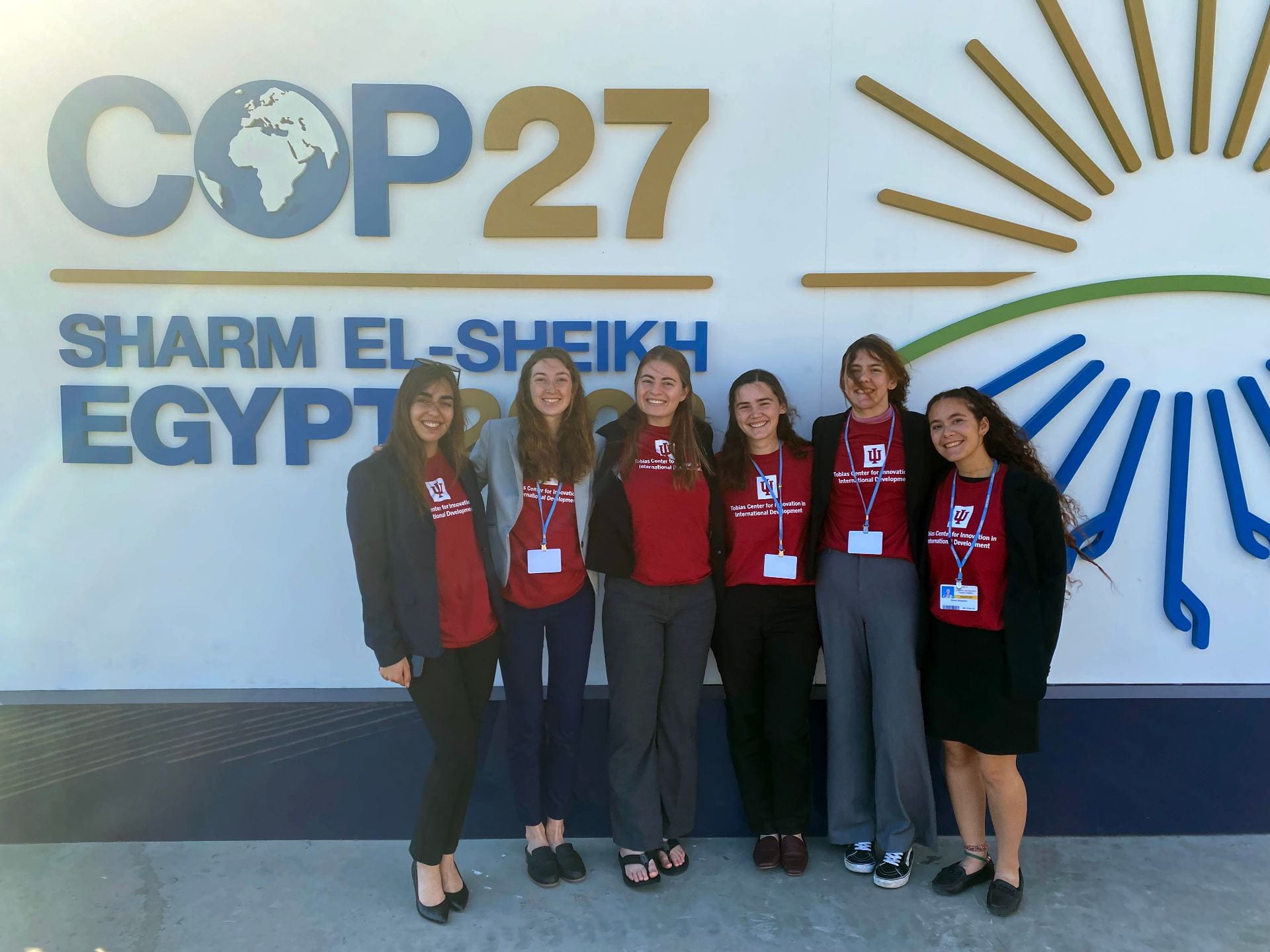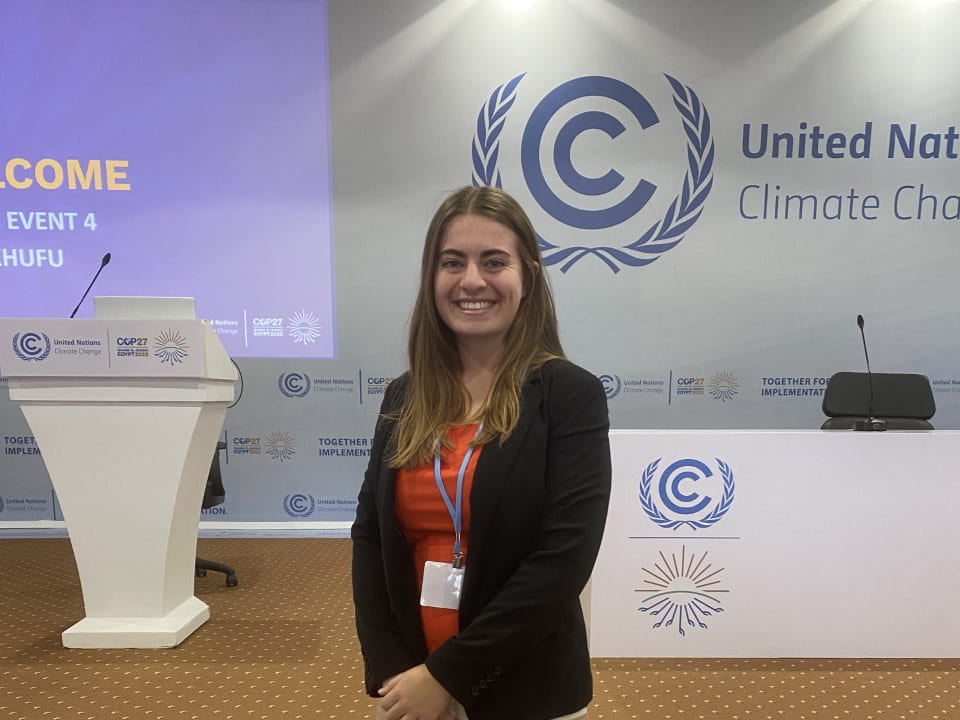
Kara Lehner, center, was one of 14 IU undergraduates attending COP27 as a delegate.
BLOOMINGTON, Ind. – For two weeks in November, much of the world’s attention was focused on Sharm El Sheikh, Egypt, and the United Nations Climate Change Conference COP27.
Among those in attendance as part of an official Indiana University delegation was Kara Lehner, a senior in the Kelley School of Business, and her instructor, Kelly Eskew, a clinical professor of business law and ethics at Kelley.
Lehner, who serves as co-president of the Net Impact Sustainable Business Club at Kelley, was one of two Kelley students and 14 IU undergraduates overall who were enrolled in a research-oriented class taught by Jessica O’Reilly, an associate professor of international studies in the Hamilton Lugar School of Global and International Studies and leader of IU’s delegation.
Undergraduate and graduate students can apply to be in the class, and selection is highly competitive due to the limited number of COP27 credentials available. Eskew assisted O’Reilly this year and was able to attend the conference for the second year in a row.

Tom Reichert
“Climate issues are on the minds of investors and thus businesses – and every executive department of the government. This course prepares students like Kara to understand the science as well as the political challenges around climate action, and to contribute to market-based, regulatory, and diplomacy-related solutions,” Eskew said. “It also ensures that she will be a valued and knowledgeable contributor to any organization as well as to the ongoing public discourse on this existential threat to global well-being.”
At the conference, Lehner had the opportunity to meet and talk with Tom Reichert, a 1991 Kelley MBA graduate who is chief executive officer of ERM, the largest sustainability consulting company in the world. Another Kelley alumnus students met at COP27 was Steve Lutes, vice president for Middle East Affairs at the U.S. Chamber of Commerce.
Reichert and ERM were active at COP27. He participated in the Sustainable Innovation Forum, speaking about the challenges companies face when developing their decarbonization strategies, and gave the keynote speech at the World Business Council for Sustainable Development.
Meeting Reichert meant a lot to Lehner, who spent her time at the conference researching how governments, associations, and companies allocate resources to Carbon Capture Utilization and Storage (CCUS) and why profitable future market growth of the industry is anticipated.
“In addition to providing information about my research, this experience completely altered my perspective on climate change and provided me so many new cultural experiences,” she said. “I am incredibly grateful for this opportunity to conduct my research and connect with many scholars and passionate individuals committed to combating climate change.”

Kara Lahner attended sessions along with other delegates and interviewed dignitaries.
IU published an article, “Delegation of IU students, faculty attend COP27,” that provides a broad overview about the class and the IU delegation’s experience. Here’s a Q&A with Lehner about her own experience and how future students can apply:
Q: How did you find out about the class?
A: I found out about the class through Kelly Eskew. She sat in on the class last year and went to COP26 in Glasgow. I was in Professor Eskew’s class at the time, and she told our class about her experience and encouraged me to apply.
Q: Where did I apply and what is involved?
A: Every spring, there is an information session before spring break, and this is where Professor Jessica O’Reilly sends out an application link. The class is called “I434, International Climate Governance,” and is in the Hamilton Lugar School of International Studies. For this coming spring, the information session date has not been set yet, but likely will take place after Christmas break. The class always takes place in the fall because that’s when the conference takes place. Next year COP28 will be in Dubai.
For the application process, students must come up with a research topic of something they are interested in researching during the semester and while at the COP. You must write a one-page outline of your research question and what you hope to achieve by taking the class. Students are then selected to be in the class and will be notified before spring break.
Q: What was the class like and what did it involve?
A: The class dives into a deep analysis of the Paris Agreement and other important climate documents, such as the Kyoto Protocol. The class meets once a week for two and half hours. The preparation for each class can be quite lengthy as there is a lot of reading to prepare for class discussion each week. All of this is done in preparation for the trip to COP, which is always two weeks in early November. Every student gets to attend the COP for one week, so half of the class goes the first week and the other half goes the second week. What week you go is determined by your research topic and when the events occurring at the COP that align with your research topic.
Q: What was expected of you while attending COP27?
A: It was expected that we were in the conference venue for almost every day of the trip — we got one free day — and we were there from 8 a.m. to 6 p.m., although most people tended to stay later for events and happy hours to network. While at the COP, we spent each day going to different pavilions and events, and we were required to conduct at least five interviews relating to our research.
Before going on the trip, students are required to present their research for the semester and submit a paper on what we knew going into the conference. After we returned from the COP, you also presented and submitted an essay on our findings from the conference related to our research.
Q: What did I learn?
A: During my time at COP27, I learned so much about both my research topic and other climate topics. I’ve spent the semester researching carbon capture utilization and storage (CCUS), specifically looking at future market growth and what investments governments, associations, and companies are making in Carbon Capture Utilization and Storage technology.
At the COP, I was able to attend many events on Carbon Capture Utilization and Storage and talk to many scholars, CCUS corporations, and CCUS innovators about the work that they were doing. This trip also provided me a lot of new cultural experiences as I tried new foods, explored Sharm El-Sheikh, and met people from all over the world.
Q: What were some major takeaways you brought home from Sharm El-Sheikh?
A: Overall, from the conference, there were a few major outcomes. The first is that a loss and damage fund has been created. While the specifics haven’t been worked out yet — they are set to be discussed over the next year — this is a huge win! Creation of this fund has been in discussion for about 30 years, so it was really exciting to see something come out of COP27. Phasing down fossil fuels was not made mandatory, and the final text only said, “efforts should go towards phasing down fossil fuels,” which is disappointing.
One other takeaway was that nature-based solutions were the buzzword of the COP. Everyone was talking about them, especially in negotiations which is exciting as this will likely be a big topic at the next few COPs.
From my research, my main takeaways are that the CCUS market is expected to reach a value of $33.6 billion by 2030, which is huge considering it’s only valued at roughly $1 billion today. It’s also estimated that total carbon capture capacity will be 1,670.2 million tons per year by 2030. From the COP, I learned that the main barriers holding CCUS companies back from scaling up are a lack of private investment, lack of effective regulation, and lack of overall standards and a price of carbon.
Q: Other highlights?
A: A key highlight for me at the conference was meeting with Tom Reichert, the CEO of ERM. ERM is the largest sustainability consulting company in the world. Not only did I get to talk with Tom about his thoughts on the Carbon Capture Utilization and Storage market, but also about other carbon reducing projects ERM is doing and how rapidly the sustainable consulting industry is growing.
I also enjoyed hearing from some of the largest Carbon Capture Utilization and Storage company CEOs on a few panels I attended. CEO’s from Carbfix, Climeworks and Aker Solutions were there and able to discuss future growth of the industry and their companies.
While not directly related to my research, I also was very excited to see some high-level people speak at the conference, such as United Nations Secretary General António Guterres, Al Gore, and Michael Bloomberg. Overall, this was an incredible opportunity that I am very grateful for, and I feel like I’ve completely expanded my perspective and knowledge of climate change.
Editor’s note: The COP27 trip was funded by the Tobias Center for Innovation in International Development in the Hamilton Lugar School and the Kelley School’s Center for International Business Education and Research, or CIBER.